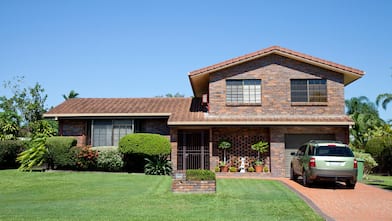Highlights
The ocean, flooding, hail, and heavy storms are the key culprits behind shoreline erosion.
Seawalls, levees, and terminal groins can help protect against shoreline erosion.
Lush vegetation and riprap rock can naturally prevent or mitigate erosion.
The last thing you want as you relax on the shoreline of your waterfront property is a receding shoreline that looks anything but relaxing. But if you aren’t on top of protecting your shoreline from the elements and traffic, then you might be in for a surprise as nature takes its course over time. Keep on top of your shoreline property with these 10 shoreline erosion problems and tips on how to keep erosion at bay.
1. Storm Water
Storms are one of the biggest factors for shoreline erosion problems. Because of climate change, ocean warming has increased around 0.13 degrees Celsius for every decade in the last 100 years, increasing the likelihood of catastrophic storm systems.
But ocean weather isn’t the only cause of shoreline erosion. Regular storms also play a part in erosion for those with lakefront properties. Flooding, hail, and heavy storms will erode shorelines that are already vulnerable due to loose sediment and decreased vegetation, making your shoreline smaller over time. Sheetwash can also occur if there’s little vegetation, leading to an uncontrollable flow of rainwater across the surface of your shoreline.
Without interventions in place, such as increased plant life, the sheetwash will eventually concentrate, where it can form grooves, rills, and gullies. When this happens, runoff water will race down the ridges and erode larger parts of your shoreline.
2. Boat Traffic
Boats create V-shaped waves called wakes, which displace water as the boat drives over the surface. This water displacement accelerates natural erosion by lapping at loose sediment and uprooting vegetation at the shoreline.
Some states, like New York, have laws in place that state that boats are not to go over 5 miles per hour (mph) if they’re within 100 feet of the shoreline. Other steps boat users can take to mitigate the effects of wakes include:
Carrying as little weight as possible in the boat.
Starting and returning at different locations.
Not using the motor in shallow waters.
Keeping the speed at 5 mph up to 500 feet away from the shoreline.
3. Foot Traffic
Frequent foot traffic across your shoreline property can prevent vegetation from growing. In turn, the soil becomes loose and loses traction from roots and plant life that keep particles packed tight. The particles then get washed away on windy, snowy, or rainy days.
4. Sea Level Rise
Global sea level rises can mean major erosion for coastal shorelines, as the higher waters mean increased high tide levels. Higher tidal waves will inch above parts of your shoreline that were previously safe from the waves, breaking away susceptible parts of your property.
According to Climate.gov, sea levels in 2020 were 3.6 inches above sea levels taken from 1993, and the annual rise in sea levels from 2006 to 2015 increased to 0.14 inches per year compared to 0.06 inches per year throughout the 20th century.
As the global sea level rises, the high tide rises with it, increasing the chances of coastal erosion. Rising and falling tides can easily move sand from your property to other locations.
5. Wind

Sandy shorelines, or shorelines with looser soil particles, are prone to wind erosion. When wind moves across the shoreline, sediment gets carried away. You’ll see this happens more commonly on properties that lack rich vegetation or fencing, which can both work as barriers to protect sediment from being carried away.
In places with especially strong winds, sand dunes can blow away entirely, depleting the amount of sand available in your area.
6. Waves
Wind doesn’t just move soil particles around; it also creates waves in the water that laps at the shoreline, eroding it. Over time, wave breaks in windy weather create a disturbance in the sediment of your property’s shoreline. This disturbance occurs at the bottom of the sediment, leading to sloping and a domino effect of more and more erosion.
A few factors that determine the severity of wave erosion include:
Fetch, or the distance that wind blows across the surface area of a body of water in a consistent direction.
The length of time the wind has blown.
Wind speeds.
Depth of the body of water.
Distance from which the waves are generating.
7. Frost Weathering
That winter wonderland just lost a little of its appeal. Despite the beauty of a frosty day, ice is a known offender to shorelines, causing erosion in its wake. Ice leads to erosion in the following steps:
When water sneaks into rocky shorelines, it wiggles its way into cracks in the rocks.
As the temperature drops and it starts to freeze, just like with a fizzy can of soda, that water will expand.
Once the water freezes and expands, those same cracks that the water seeped into will crack even more, weakening the rock.
All of this can make for a fragile shoreline prone to give way and deteriorate.
8. Soil Creep
Also called downhill creep, soil creep is a slow sinking of particles that naturally occurs due to gravity. This common cause of erosion can happen more quickly on land where animals or people frequently cross it, as the downward pressure further pushes the soil down the slope.
If your shoreline is on a downhill slope, it’s likely already shifting towards the lower part of the land. Telltale signs of soil creep include trees and plants growing at an angle, leaning fences and retaining walls, tilted powerline poles, and in more severe cases, curved tree trunks.
9. Lack of Vegetation
Plants provide more than just beauty to your landscaping; they also help prevent erosions. The roots help stabilize sediment while also absorbing stormwater runoff, and the plants above the ground help to reduce rain and hail damage to the soil underneath while slowing how quickly runoff water moves across the surface.
If your property lacks vegetation, however, all these perks go down the drain—along with your shoreline! Land with too little vegetation acts as a slide for water and sediment alike to race down into the water below. So when in doubt, plant some native trees or shrubs.
10. Erosion Control Projects
This common cause for erosion may seem counterintuitive, but in some cases, outdated erosion control projects actually make the shoreline erosion problem worse. Many of these structures are called “hard” structures because they’re made of concrete, wood, steel, or stone.
A few structures that might negatively impact natural currents and sand movement include:
Seawalls: These hard walls prevent waves from eroding the shorelines, but since they only redirect wave energy, seawalls can push waves down into the water, harming wildlife and damaging their habitat. Seawalls can also flank waves to other properties nearby, damaging your neighbor’s shoreline.
Terminal Groins: These structures are installed perpendicularly from the shore out into the water to block sand from entering by longshore currents. Groins protect shorelines on the updrift side of the groin, but shorelines on the downdrift side of the groins experience an increase in erosion and sand loss.
Levees: Like seawalls, levees are another type of artificial wall used to block water from entering beyond a certain point. Levees increase water speeds, which can speed up erosion and vegetation loss and increase downstream flooding for river sources.
Beach fill: Beach nourishments involve adding sand to a beach, but often the sand will just wash out into the ocean during stormy weather because the initial cause of the erosion wasn’t appropriately addressed.
Shoreline Erosion Solutions: Living Shorelines
Since many older project methods can do more harm than good, several states and shoreline stabilization companies have updated their techniques to more natural structural projects. These new shoreline protection methods are called living shorelines, as they take in the natural environment and work with it to create wildlife habitats and maintain the land.
Here are a few natural solutions for shoreline erosion control:
Natural Vegetation
Sometimes, simply planting native plants in areas that are at high risk for erosions is all that’s needed to help prevent sediment from loosening and eroding into the waters below. This is most likely the case for homeowners with a lakeshore property, as coastal winds, significant tidal waves, and rising sea levels don’t affect these shorelines.
The roots from the vegetation serve as a netting that keeps the soil compact and stable, while the plants themselves protect the ground from wind, water, and storm runoff.
Riprap Rock

Riprap rock is a great alternative in instances where natural vegetation cannot grow on a shoreline. This type of structure is made from natural rocks, making it an environmentally-friendly option. Your installer will place loose riprap along the shoreline to prevent the soil from facing the brunt of waves.
Fences
A sand fence is a simple method to help guard your beach shoreline against being carried away by precipitous winds. These wooden fence guards utilize slats that slow wind speed and stop sand erosion. When paired with natural vegetation like grass, sand fencing can also help prevent damage from foot traffic.
Landscaping
In properties where storm runoff and flooding are major problems, shoreline landscaping can prevent erosion. Mulching, cover crops, crushed stone on heavy traffic areas, permeable pavers, hydroseeding, and rain collection barrels are just a few ways that you can work with a shoreline landscaping professional to decrease runoff and protect your shorelines.
Consider Shoreline Restoration
Even if you take every preventative measure possible for keeping your shoreline erosion-free, there is still a chance that erosion will happen. For homes in areas prone to natural disasters, especially, be prepared for shoreline erosion.
Consider returning your shoreline property to an undeveloped state, where birds, fish, plants, and other wildlife can flourish. Increase the natural vegetation on your shoreline and implement some of the living shoreline practices above to help promote a stable shoreline.
Then remove boats, take down hard structures, and limit foot traffic in areas that have significant erosion to let nature thrive without these known causes for erosion.
Don’t Wait to Investigate Your Shoreline
Regardless of whether or not your shoreline has an erosion, you’ll want to know your property’s risk factors and take measures to protect and prevent erosion. If you wait too long and your property has already eroded, you might be disappointed to contact a local landscaping company and learn about their shoreline restoration limitations due to severe erosion.
In some states and municipalities, it’s illegal to replace lost shorelines. In other locations, you may need a permit and a large budget set aside for engineering a new shoreline. A living shoreline project can cost anywhere from $440 to $5,500 per linear foot, including installation.
Be sure to speak with your pro for an estimate and any local permit requirements, as they will be familiar with your area’s requirements and the going rates for a shoreline restoration project.

 - Allie Ogletree.jpeg?impolicy=thumbnail)



